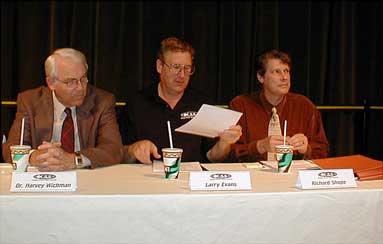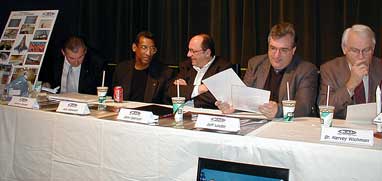






Editor: Kris Cerone
OC-NSS Hosts Columbia Forum
By Steve Bartlett
In the aftermath of the loss of Space Shuttle Columbia, the Orange County Space Society (OCSS) held a public forum on February 16 at the Discovery Science Center. The forum featured educators, space engineers, and space activists speaking on the Shuttle program, its history, legacy, and future.
Space educator and performance artist Richard Shope opened the forum with a poem dedicated to Columbia on the legend of Icarus and Daedalus. He pointed out the fact that the idea of flight is thousands of years old and that in man's quest for the sky, he sometimes falls.
 |
| Columbia Forum panel members. L-R: Dr. Harvey Wichman, Larry Evans, and Richard Shope. Photo courtesy Steve Bartlett. |
To borrow a line from Star Trek, 'Risk is what we're all about, people!'
exclaimed Jim Busby of the Aerospace Legacy Foundation. He emphasized the importance of space exploration and how the sacrifices made in the quest for the stars cannot be forgotten. In his view, the best tribute to the Columbia crew, and that of the lost Shuttle Challenger and the crew in the Apollo 1 fire, is to learn from the past mistakes and move on.
Busby later went on to detail the Shuttle's current configuration and the events and compromises that went into its design.
Ivor Dawson, head of the Traveling Space Museum, described the enthusiasm of young people for space travel and how the museum helps them to understand what we're doing in space and why. This has been particularly true following the loss of Columbia, where the museum staff has had to explain the failure and how it might have happened.
This enthusiasm for space travel also extends to adults, as John Spencer, head of the Space Tourism Society, reminded the audience of the public excitement over the flight of space tourist Dennis Tito to the Alpha Space Station. This is about the fulfillment of dreams,
said Spencer.
Larry Evans, president of the Orange County Space Society, gave an overview of the Shuttle program from its inception to some of its major milestones. He recalled with fondness the first flight of Columbia in April of 1981, as well as its seventh, where Dr. Sally Ride became the first American woman in space. In all, Columbia flew to orbit 28 times. He also reiterated the need to go on with exploration of the cosmos.
Any country or people who don't explore will stagnate and die,
said Evans.
 |
| OCSS Columbia Forum panelists. L-R: Dr. Jim Busby, Ivor Dawson, John Spencer, Jeff Laube, Dr. Harvy Wichman |
But for all of the program's successes, the panelists felt that it was time to move beyond the Shuttle and develop a newer, more capable, and lower cost vehicle. Jeff Laube, an engineer at Northrop Grumman Corporation, told the audience about ongoing work to develop reusable launch vehicles as part of NASA's Space Launch Initiative. These new vehicles will incorporate new technologies, more reliable engines, and lighter weight materials. Many of these technologies resulted from lessons learned on the Shuttle program.
Unfortunately, some lessons are learned at a high price,
said Laube.
Dr. Harvey Wichman, head of the Applied Psychology program at Claremont McKenna College, has worked on some of the Shuttle improvements and human factors issues over the years. He noted that progress has been made each year to improve the Shuttle's capabilities but it was Time to make a big break and build another kind of machine.
A reporter from the Los Angeles Times had asked Wichman following the loss of Columbia how long a setback there would be in the Shuttle program. Wichman replied that he hoed that this would be the impetus to leapfrog forward to better, more capable vehicles.
The panelists later fielded questions on Shuttle privatization, space commercialization, Shuttle upgrades, and the need for better in-flight inspection capability of the Shuttle's heat shield. The program ended with the showing of a videotape from the Columbia memorial at the National Cathedral.
Read some writings of OASIS members in the February issue.
Copyright © 1998-2003 Organization for the Advancement of Space Industrialization and Settlement. All Rights Reserved.